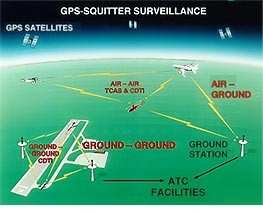Annual Report To Congress Highlights Plan To Use ADS-B, RNP,
CDA Procedures
 Editor's Note: The
following is the FAA's updated Fact Sheet on its progress in
implementing its Next Generation Air Transportation System, known
as NGATS or NextGen.
Editor's Note: The
following is the FAA's updated Fact Sheet on its progress in
implementing its Next Generation Air Transportation System, known
as NGATS or NextGen.
The FAA is completely transforming air traffic control from a
ground-based system of radars to a satellite-based system through
the Next Generation (NextGen) Air Transportation System Integrated
National Plan. NextGen is critically important because the current
system will not be able to handle traffic that is expected to
increase to one billion passengers by 2015 and double current
levels by 2025.
Planning and implementing NextGen is being carried out by a
unique public/private partnership called the Joint Planning and
Development Office (JPDO). The JPDO is made up of representatives
from the Departments of Transportation, Defense, Homeland Security,
Commerce, the FAA, NASA and the White House Office of Science and
Technology Policy. It is also supported, through the JPDO, by a
wide range of aviation experts from across the private sector.
This month the JPDO has delivered its annual report to Congress
on progress in making the transition to NextGen.
Planning
The JPDO is developing the Concept of Operations (ConOps), an
Enterprise Architecture and the Integrated Work Plan (IWP) for
NextGen.
- The ConOps describes how NextGen will work in
2025 and what it will look like from various stakeholders’
perspectives. This is important in developing the structure, policy
and procedures necessary to make NextGen a reality. The first draft
of the ConOps was completed last August. The initial baseline of
the ConOps (version 2.0) will be completed this spring and will
address the full scope of NextGen operations.
- The Enterprise Architecture is much like a set
of blueprints. It defines the key capabilities of NextGen and how
they fit together. A version of the Enterprise Architecture that is
synchronized with ConOps version 2.0 will be published this
spring.
- The Integrated Work Plan (IWP) complements the
ConOps and Enterprise Architecture by providing the programmatic
and funding details of the transition to NextGen. The initial
baseline of the IWP will be available in mid summer of this
year.
- These three documents will be used as guides to our planning,
implementing and funding of Next Gen.
Technology
The following is a summary of our progress in implementing some
of the major technologies that will form the underlying structure
of NextGen.
-
 Automatic Dependent
Surveillance-Broadcast (ADSB). ADS-B, a satellite-based
technology that broadcasts aircraft identification, position and
speed with once-per-second updates, is the backbone of NextGen. A
national ADS-B program office has been established. The Capstone
program in Alaska, which uses ADS-B in a non-radar environment, has
resulted in a 40% drop in general aviation accidents. A partnership
with the helicopter industry will bring ADS-B to the Gulf of Mexico
in December 2009. United Parcel Service has outfitted a fleet of
300 aircraft with ADS-B for use at its Louisville hub, with similar
services planned for Philadelphia. The airline is seeing a 30%
reduction in noise and a 34% decline in emissions for
ADS-B-equipped aircraft. The contract to deploy the ADS-B system
will be awarded to one of three competing contractors — ITT,
Raytheon or Lockheed Martin — in July. A Notice of Proposed
Rulemaking with a timeline for the avionics will be issued in
September.
Automatic Dependent
Surveillance-Broadcast (ADSB). ADS-B, a satellite-based
technology that broadcasts aircraft identification, position and
speed with once-per-second updates, is the backbone of NextGen. A
national ADS-B program office has been established. The Capstone
program in Alaska, which uses ADS-B in a non-radar environment, has
resulted in a 40% drop in general aviation accidents. A partnership
with the helicopter industry will bring ADS-B to the Gulf of Mexico
in December 2009. United Parcel Service has outfitted a fleet of
300 aircraft with ADS-B for use at its Louisville hub, with similar
services planned for Philadelphia. The airline is seeing a 30%
reduction in noise and a 34% decline in emissions for
ADS-B-equipped aircraft. The contract to deploy the ADS-B system
will be awarded to one of three competing contractors — ITT,
Raytheon or Lockheed Martin — in July. A Notice of Proposed
Rulemaking with a timeline for the avionics will be issued in
September.
- Required Navigation Performance (RNP). RNP is
a set of standards that measure location accuracy in the airspace.
Increased navigational precision by aircraft can reduce spacing
— and thus increase capacity, especially at congested
airports — without compromising safety. Substantial progress
with RNP has been made to date, and a total of at least 200 RNP
approach procedures are expected by 2011.
Safety Management System (SMS). The safety programs of the next
generation must evolve from traditional post-accident data analysis
to a more integrated evaluation. SMS will improve the collection
and analysis of safety data to identify emerging threats and thus
prevent future accidents.
- Continuous Descent Approach (CDA). CDA is a
procedure that optimizes the aircraft approach from the beginning
of its descent to touch-down. With CDA, noise and emission levels
are substantially reduced. The JPDO will be working with several
airports to implement CDA for night operations. A demonstration of
CDA in a practical environment is one of the JPDO’s 2007
objectives.
Cost
Over the next five years, the FAA’s investment portfolio
for NextGen — key investments that will enable the
transformation to a satellite-based system to take place —
will require an estimated $4.6 billion. That total is made up of
$4.3 billion in Air Traffic Organization capital and $300 million
in research. These funds are provided in the President’s FY
08 budget.
Of the $4.3 billion, $3 billion is for efforts that will be
initiated over the next five years. An estimated $1.3 billion would
be directed to ongoing programs that directly support NextGen.

Based on the current NextGen plan, major investments are also
expected for the period from fiscal year 2013 to FY 2017. Total FAA
spending over the first ten years is expected to range from $8
billion to $10 billion, and estimates through 2025 range from $15
billion to $22 billion in FAA investments.
The FAA will continuously refine these estimates, working
closely with our users as we implement new cost-based financing
mechanisms. These are presented in the agency’s financing
reform proposal, enactment of which is critical to the successful
transformation of the nation’s airspace system.
 ANN's Daily Aero-Linx (04.16.24)
ANN's Daily Aero-Linx (04.16.24) Aero-News: Quote of the Day (04.16.24)
Aero-News: Quote of the Day (04.16.24) Airborne 04.10.24: SnF24!, A50 Heritage Reveal, HeliCycle!, Montaer MC-01
Airborne 04.10.24: SnF24!, A50 Heritage Reveal, HeliCycle!, Montaer MC-01 Airborne 04.12.24: SnF24!, G100UL Is Here, Holy Micro, Plane Tags
Airborne 04.12.24: SnF24!, G100UL Is Here, Holy Micro, Plane Tags Airborne-Flight Training 04.17.24: Feds Need Controllers, Spirit Delay, Redbird
Airborne-Flight Training 04.17.24: Feds Need Controllers, Spirit Delay, Redbird





